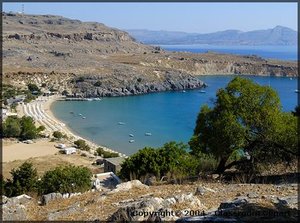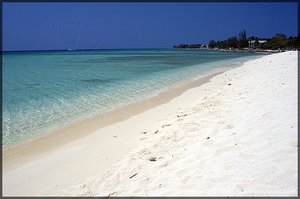Coast
|
|
The coast is defined as the part of the land adjoining or near the ocean. A coastline refers to a particular length of coast. The term coastal describes a location as being on or near a coast.
Coast is a very specific term and is only applied to that part of an island or continent that borders an ocean or its saltwater tributaries. A pelagic coast simply refers to a coast which fronts the open ocean, as opposed to a more sheltered coast in a gulf or bay. A shore on the other hand, can refer to parts of the land which adjoin any large body of water, including oceans (sea shore) and lakes (lake shore). Similarly, the somewhat related term bank refers to the land alongside or sloping down to a river (river bank) or lake.
While many scientific experts might agree on a common definition of the term "coast", the delineation of the inland extents of a coast differ according to jurisdiction, with many scientific and government authorities in various countries differing for economic and social policy reasons. This is usually because defining lands as part of a coast may be seen to have environmental implications which would prevent development or attach regulations to their use.
| Contents |
Environmental importance
The coast and its adjacent areas on and off shore is an important part of a local ecosystem as the mixture of freshwater and saltwater in estuaries provides many nutrients for marine life. Salt marshes and beaches also support a diversity of plants, animals, and insects crucial to the food chain.
Like the ocean which shapes them, coasts are a dynamic environment with constant change. The earth's natural processes, particularly sea level rise, waves and various weather phenomena, have resulted in the erosion and reshaping of coasts as well as flooding and creation of continental shelves and drowned river valleys.
Human impacts
Coasts also face many environmental challenges relating to human-induced impacts. The human influence on climate change is thought to be a contributing factor of an accelerated trend in sea level rise which threatens coastal habitat as natural systems struggle to adapt faster. Human development of coastal land, particularly for recreational or industrial uses are similarly threatened by sea level rise, but also contribute to aesthetic problems of land use and reduced natural coastal habitat.
Pollution is an ongoing concern along coasts with garbage and industrial debris littering beaches and sometimes entire coastlines. The transportation of oil and petroleum on tankers is a major hzard both for the open ocean and along coasts, particularly when large oil spills occur. Another major hazard for coastal marine life is the large number of small oil spills created by large and small vessels powered by petroleum which flush bilge water directly into the ocean.
Both the terms coast and coastal are often used to describe a geographic location or region. For example, the "Pacific Coast" of North America or the "Atlantic Coast" of Africa, the "Arctic Coast" of Asia, or the "Mediterranean Coast" of France. Similarly islands may refer to specific coasts such as the "North Sea Coast" of the United Kingdom or the "Gulf of St. Lawrence Coast" of Newfoundland.
A large part of the global population inhabits areas near a coast, partly to take advantage of marine resources such as fish, but more importantly to participate in seaborne trade with other nations. Many of the world's major cities that have developed in recent centuries were built on or near good harbours and have large port facilities to take advantage of marine transportation. Jurisdictions which are landlocked and have no coast are often at an economic disadvantage with overseas trade being more difficult; sometimes being forced to go to extravagent measures such as building canals to permit ocean-going vessels to travel inland.
Coasts are also an important draw for tourists, especially those with beaches and warm water. In many island nations such as those of the Mediterranean, South Pacific and Caribbean, tourism by those who come to enjoy the coast is central to the economy. Coasts are popular destinations because of recreational activities such as swimming, fishing, surfing, boating, and sun bathing.
Many tourists and residents also enjoy the salt air by the sea coast which some consider to have health benefits. Coastal weather is heavily influenced by the ocean and while this can sometimes result in dangerous storms such as Nor'easters and hurricanes, the coastal climate is often cooler and more temperate than corresponding inland areas. Consequently tourists from areas experiencing extremely warm and humid weather seek coastal areas for these reasons.
The coast, especially for isolated nations such as Japan, the United Kingdom, Australia, New Zealand, Canada or the United States is often a crucial defensive frontier, both for warding off military invaders but also smugglers and illegal migrants. Coastal defenses have thus long been erected in many nations. Most coastal countries also have a navy and some form of coast guard.
Types of coast
- emergent coastline - coast has risen or sea level has fallen from previous level.
- submergent coastline - coast has fallen or sea level has risen from previous level.
- concordant coastline - rock bands run parallel to shore.
- discordant coastline - rock bands run perpendicular to shore.
See also
Coastal landforms & features

- arch — archipelago
- bar — barrier island — bay — beach — boondock
- cape — cave — cliff — cove
- delta — dune system
- estuary
- fjord
- gulf
- headland
- island — island arc
- lagoon
- mud flat
- peninsula
- raised beach — ria
- salt marsh — sea — spit — stack — stump
- tombolo
- wave cut cliff — wave cut notch — wave cut platform
- How long is a coastline?
Processes
- attrition
- currents
- denudation — deposition
- erosion
- flooding
- longshore drift
- saltation — sea level change (eustatic — isostatic) — sedimentation — sediment transportation — solution — sub-aerial processes — suspension
- tides
- waves — weathering
Related topics & articles
- Coral reefs
- Earth science
- Geography — Geology — Geomorphology
- How Long Is the Coast of Britain? Statistical Self-Similarity and Fractional Dimension
- Marine biology
- Ocean
- geography
- Coastal management
Famous coasts
- Gold Coast (Ghana)
- Grain Coast (Liberia)
- Slave Coast (Benin)
- Skeleton Coast of Namibia
- Barbary Coast in the Maghreb, the coastal plain of North Africa
- Gold Coast, Australia
- Gold Coast, Florida and "Gold Coast" of Long Island, among other luxurious "Gold Coast" marine resorts
- Italian Riviera - Italy
- Jurassic Coast (England)
- West Coast, New Zealand
- East Coast of the United States
- West Coast of the United States
- Costa Brava and Costa del Sol, the Mediterranean coasts of Spain
- Adriatic Coast of Croatia and neighbouring countries
- The North Slope of coastal Alaska


